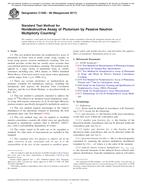Potřebujeme váš souhlas k využití jednotlivých dat, aby se vám mimo jiné mohly ukazovat informace týkající se vašich zájmů. Souhlas udělíte kliknutím na tlačítko „OK“.
ASTM C1500-08(2017)
Standard Test Method for Nondestructive Assay of Plutonium by Passive Neutron Multiplicity Counting
Přeložit název
NORMA vydána dne 1.1.2017
Informace o normě:
Označení normy: ASTM C1500-08(2017)
Datum vydání normy: 1.1.2017
Kód zboží: NS-674025
Počet stran: 14
Přibližná hmotnost: 42 g (0.09 liber)
Země: Americká technická norma
Kategorie: Technické normy ASTM
Kategorie - podobné normy:
Anotace textu normy ASTM C1500-08(2017) :
Keywords:
ICS Number Code 13.030.30 (Special wastes)
Doplňující informace
| Significance and Use | ||||||||||||
|
5.1 This test method is useful for determining the plutonium content of items such as impure Pu oxide, mixed Pu/U oxide, oxidized Pu metal, Pu scrap and waste, Pu process residues, and weapons components. 5.2 Measurements made with this test method may be suitable for safeguards or waste characterization requirements such as: 5.2.1 Nuclear materials accountability, 5.2.2 Inventory verification (7), 5.2.3 Confirmation of nuclear materials content 5.2.4 Resolution of shipper/receiver differences 5.2.5 Excess weapons materials inspections 5.2.6 Safeguards termination on waste 5.2.7 Determination of fissile equivalent content 5.3 A significant feature of neutron multiplicity counting is its ability to capture more information than neutron coincidence counting because of the availability of a third measured parameter, leading to reduced measurement bias for most material categories for which suitable precision can be attained. This feature also makes it possible to assay some in-plant materials that are not amenable to conventional coincidence counting, including moist or impure plutonium oxide, oxidized metal, and some categories of scrap, waste, and residues 5.4 Calibration for many material types does not require representative standards. Thus, the technique can be used for inventory verification without calibration standards 5.4.1 The repeatability of the measurement results due to counting statistics is related to the quantity of nuclear material, interfering neutrons, and the count time of the measurement 5.4.2 For certain materials such as small Pu, items of less than 1 g, some Pu-bearing waste, or very impure Pu process residues where the (α,n) reaction rate overwhelms the triples signal, multiplicity information may not be useful because of the poor counting statistics of the triple coincidences within practical counting times 5.5 For pure Pu metal, pure oxide, or other well-characterized materials, the additional multiplicity information is not needed, and conventional coincidence counting will provide better repeatability because the low counting statistics of the triple coincidences are not used. Conventional coincidence information can be obtained either by changing to coincidence analyzer mode, or analyzing the multiplicity data in coincidence mode. 5.6 The mathematical analysis of neutron multiplicity data is based on several assumptions that are detailed in Annex A1. The mathematical model considered is a point in space, with assumptions that neutron detection efficiency, die-away time, and multiplication are constant across the entire item 5.6.1 Bias in passive neutron multiplicity measurements is related to deviations from the “point model” such as variations in detection efficiency, matrix composition, or distribution of nuclear material in the item's interior. 5.6.2 Heterogeneity in the distribution of nuclear material, neutron moderators, and neutron absorbers may introduce biases that affect the accuracy of the results. Measurements made on items with homogeneous contents will be more accurate than those made on items with inhomogeneous contents. |
||||||||||||
| 1. Scope | ||||||||||||
|
1.1 This test method describes the nondestructive assay of plutonium in forms such as metal, oxide, scrap, residue, or waste using passive neutron multiplicity counting. This test method provides results that are usually more accurate than conventional neutron coincidence counting. The method can be applied to a large variety of plutonium items in various containers including cans, 208-L drums, or 1900-L Standard Waste Boxes. It has been used to assay items whose plutonium content ranges from 1 g to 1000s of g. 1.2 There are several electronics or mathematical approaches available for multiplicity analysis, including the multiplicity shift register, the Euratom Time Correlation Analyzer, and the List Mode Module, as described briefly in Ref. 1.3 This test method is primarily intended to address the assay of 240Pu-effective by moments-based multiplicity analysis using shift register electronics 1.4 This test method requires knowledge of the relative abundances of the plutonium isotopes to determine the total plutonium mass (See Test Method C1030). 1.5 This test method may also be applied to modified neutron coincidence counters (4) which were not specifically designed as multiplicity counters (that is, HLNCC, AWCC, etc), with a corresponding degradation of results. 1.6 The values stated in SI units are to be regarded as standard. No other units of measurement are included in this standard. 1.7 This standard does not purport to address all of the safety concerns, if any, associated with its use. It is the responsibility of the user of this standard to establish appropriate safety and health practices and determine the applicability of regulatory limitations prior to use. |
||||||||||||
| 2. Referenced Documents | ||||||||||||
|




 Cookies
Cookies
